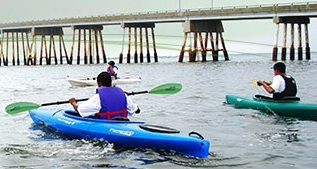 With the pressures of continuing coastal growth, offshore energy development, and the escalating effects of climate change, there are increasing demands on Chesapeake, coastal and ocean resources – our Blue Infrastructure. Coastal and estuarine habitats shield us from storms; filter pollutants to maintain water quality; provide shelter, nesting and nursery grounds for fish and wildlife; and provide access to beaches. The resources within these regions are critical for commerce, recreation, energy, environment, and our quality of life. As new uses of these regions become a reality, there are increasing demands on the available space and resources.
With the pressures of continuing coastal growth, offshore energy development, and the escalating effects of climate change, there are increasing demands on Chesapeake, coastal and ocean resources – our Blue Infrastructure. Coastal and estuarine habitats shield us from storms; filter pollutants to maintain water quality; provide shelter, nesting and nursery grounds for fish and wildlife; and provide access to beaches. The resources within these regions are critical for commerce, recreation, energy, environment, and our quality of life. As new uses of these regions become a reality, there are increasing demands on the available space and resources.
For the past three decades, Maryland’s Chesapeake & Coastal Service (CCS) has helped the state respond to increasing demands - working to reduce the environmental impacts of coastal development, resolve significant conflicts between competing coastal uses, and to provide critical assistance to local governments in coastal planning and resource protection.
CCS constantly seeks ways to improve coastal management, working with regional, state, and private partners to ensure thriving coastal communities and ecosystems and their continued capacity to serve vital ecological, economic and recreational needs. To meet this goal, we: work to assess the state’s Blue Infrastructure and use marine spatial planning tools to evaluate compatible coastal uses; work to restore habitats, create public access opportunities and protect important coastal habitats through acquisition; In the face of climate change and sea level rise, work to plan for habitat changes and identify coastal habitat adaptation options; and we conduct research, provide technical services, and distribute federal and state funds to enable on-the-ground projects that benefit Maryland’s coastal communities.
Maryland’s Coastal Zone Management (CZM) Program, established under Section 309 of the Coastal Zone Management Act, is developing a 5 year strategy to inform program investments in the following enhancement areas: wetlands, coastal hazards, public access, marine debris, cumulative and secondary impacts, special area management plans (SAMPs), oceans and great lakes resources, energy and government facility siting, and aquaculture.
This strategy is open for public feedback through August 15, 2025 and we appreciate if you would take our
8 question survey to provide your input.